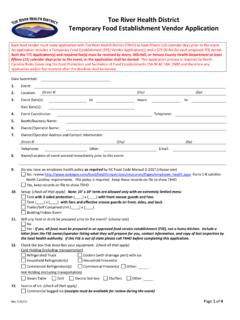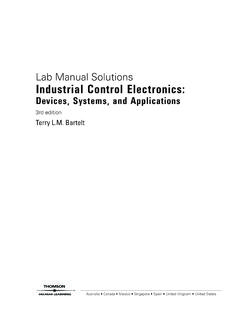Transcription of Daily Temperature Chart Instructions - Farner-Bocken
1 Daily Temperature Chart Instructions It's a MUST DO -- Taking & recording food temperatures with an accurate stem thermometer is a critical element to insuring your restaurant, your employees, and your chain are serving SAFE FOOD to our customers. It takes just a few minutes a day. If Managers / Owners/ Franchisees require Temperature recording to be a Daily routine, there are several benefits: Safer, wholesome better tasting food;. Shelf life of foods will be extended by knowing exactly how your food temperatures run from day to day;. Less food waste by maintaining correct food temperatures ;. Great Daily learning tool to build food safety skills for crew / employees;. Improved results on health inspections and internal company quality reports;. Faster awareness of refrigeration maintenance problems;. The very best defense in the case of a foodborne illness complaint;. Your restaurant and/or chain will move into a HACCP-oriented method of complete food safety.
2 HACCP (Hazard Analysis Critical Control Point) is a dynamic system being used in food processing and food service to help food managers and food workers identify and control potential problems before they happen. It is a very systematic approach based on controlling time, Temperature , and specific factors that are known to contribute to foodborne disease outbreaks. HACCP requires record keeping as one of the important steps to make the system work. These 5 charts are simple to use and have some Instructions on each sheet to help guide managers and employees. Different color sheets for each of the 5 types are suggested to make them easier for employees to refer to. Teach your employees during orientation how to use, sanitize, and calibrate a thermometer. Delegate the responsibility of completing the charts to employees. Even though the manager takes some temperatures also, this is an employee task & they must KNOW HOW IMPORTANT IT IS and how to do it.
3 Change in the FOOD CODE: The 2005 FDA Food Code allows hot foods to be held at 135 F rather than 140 F as a minimum, so the Temperature Danger Zone is now 41 F to 135 F. Check your local regulations on all required temperatures , as they may vary. Many states are still require 140 F. Hang or locate the charts in the appropriate work area on clip boards (not in a managers office). Retain the completed records for at least 60 days in a 3 ring binder (the food safety experts suggest 6 months). You can obtain an electronic version of the 5 charts at our website at (left corner of main page). If you would like the blank charts sent to you by e-mail so you can customize them, contact FoodHandler at #800-338-4433, ext. 302 or send an e-mail to: or Chart #1 Hot & cold Temp. Monitoring -- This is a 2 day Chart for spot checking perishable foods at 2 hour intervals throughout the day. Place this Chart by the preparation areas. Chart #2 Cooler / Refrigeration Chart -- This Chart can be used for several days and is to check air Temperature of refrigeration units & freezers.
4 Keep one on each unit. Chart #3 Time & Temperature Preparation Log -- This Chart is for maintaining temps. for foods prepared in advance in quantity, such as catering orders that take lots of prep time. Notice there's a box for time &. Temperature to record each product every hour during prep and every 2 hours during storage before customer delivery or pick-up. Chart #4 Receiving: Temperature / Quality Log -- Spot check perishable foods as they are received and note any poor quality and/or Temperature issues. Chart #5 HACCP 6 Hour Safe Cooling Chart -- Use this Chart for recording and monitoring the cooling time and Temperature of soups, sauces, roasts, beans, or rice that is prepared in advance & cooled for later use. The 2005 FDA Food Code allows a total of 6 hours cooling in 2 Temperature stages. FOODHANDLER SAFETY MGMT. SERVICES /40 Marcus Drive, Melville, NY 11747 / 800-338-4433, EXT. 302 or 306. Hot / cold Food Temperature Monitoring Chart #1.
5 Week of: CIRCLE . Day 1: M - T- W- TH -F- SA- SU Day 2: M -T - W- TH- F- SA- SU. Menu Items AM temps. PM temps. AM temps. PM temps. time 7 9 11 1 3 5 7 9 11 1 3 5. cold Foods Hot Foods 7 9 11 1 3 5 7 9 11 1 3 5. * Spot check internal food temps. with a sanitized stem thermometer Recommended internal Temperature of cold FOODS 41 F or below (2005 FDA Food Code). Recommended internal Temperature of HOT FOODS 140 F or above (2005 FDA Food Code allows 135 F, but some states have not adopted the lower hot hold temp. check local regulations). Recommended internal Temperature of REHEATED FOODS 165 F or above in 2 hours or less Check local food regulations to confirm your requirements FOODHANDLER SAFETY MGMT. SERVICES /40 Marcus Drive, Melville, NY 11747 / 800-338-4433, EXT. 302 or 306. Cooler Refrigeration Temperature Chart #2. Month Cooler / Freezer #. (Record ambient or air temperture). 6:00 10:00 2:00 6:00 10:00 Date Temp. Temp. Temp. Temp. Temp.
6 Initials / Comments Reviewed by: Date: Internal cold food temperatures should not be over 41 F. Freezer Temperature should be 0 F or below 35 to 38 F is ideal air Temperature for most refrigeration, but lower Temperature increases shelf life of foods. Remember the food Temperature will always be higher than the air Temperature in the cooler. (Example: If the air Temperature is 38 F, you internal food Temperature might be 40 F). FOODHANDLER SAFETY MGMT. SERVICES /40 Marcus Drive, Melville, NY 11747 / 800-338-4433, EXT. 302 or 306. Time / Temperature Food Preparation Log (For foods prepared in advance of service, catering, etc.). Chart #3. (Record at least every 2 hours). Date: Food Item: time temp time temp time temp time temp time temp time temp time temp time temp time temp time temp time temp Use log for production steps from storage / prep/ cold hold / cooking / hot hold / cooling / reheat Use a sanitized stem thermometer & check the thickest part of the food Prepare small portions to limit the time food is in the Temperature danger zone 41 to 135 F.
7 (some states require 140 F hot holding minimum Temperature ). Total time between 41 and 135 F must not exceed 4 HOURS. FOODHANDLER SAFETY MGMT. SERVICES /40 Marcus Drive, Melville, NY 11747 / 800-338-4433, EXT. 302 or 306. Receiving: Temperature / Quality Log Chart #4. Tracking for receiving perishable food shipments Month: Date Product / Supplier Temp. Reject? Quality Comments / Initials Y/N. Spot check the temperatures with a sanitized stem thermometer when receiving Refrigerated foods for safety & quality must be received at 41 F or below Frozen foods must be 0 F. Use color labels or write the receiving date on the container for proper rotation of foods Reviewed by: Date: FOODHANDLER SAFETY MGMT. SERVICES /40 Marcus Drive, Melville, NY 11747 / 800-338-4433, EXT. 302 or 306. HACCP Safe Cooling Chart #5 Some states require 140 F for hot holding -- Check your local food safety regulations! 2005 FDA Food Code allows 6 hour TOTAL cooling time 135 F to 70 F in 2 hrs.
8 & 70 F to 41 F in 4 hrs. = 6 hrs. Food Product Name . Date . Actual start time at 135 F : AM/PM : : : : : After 1 hour F F F F F F. Temperature : : : : : : Time After 2 hours F F F F F F. Temperature (must be 70 F or below). : : : : : : Time After 3 hours F F F F F F. Temperature : : : : : : Time After 4 hours F F F F F F. Temperature : : : : : : Time After 5 hours F F F F F F. Temperature : : : : : : Time After 6 hours F F F F F F. (must be 41 F or below). Temperature : : : : : : Time Corrective Action Employee Improper Cooling of Hot Foods is the #1 Factor for Rapid Bacterial Growth which causes FOODBORNE ILLNESS! FOODHANDLER SAFETY MGMT. SERVICES /40 Marcus Drive, Melville, NY 11747 / 800-338-4433, EXT. 302 or 306.







